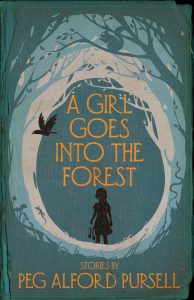by KAYLA FORREST

Peg Alford Pursell, A Girl Goes into the Forest (Dzanc Books, 2019), pp. 226.
“We tell ourselves stories in order to live…We live entirely, especially if we are writers, by the imposition of a narrative line upon disparate images, by the ‘ideas’ with which we have learned to freeze the shifting phantasmagoria which is our actual experience” –Joan Didion, The White Album
As Didion relates in her opening to The White Album, so often stories help us to find meaning in a chaotic world. We create narratives out of life’s everyday events, seeing our past, present, and future as our “life’s story,” and if stories have meaning, then so too must our lives. These narratives add deeper significance to our existence as we recognize salient moments in a stream of everyday occurrences, and sometimes, feel a sense of understanding of the intricacy and mystery of life. Published by Dzanc Books, Peg Alford Pursell’s A Girl Goes into the Forest tells compelling stories of what it means to be human, creating a kaleidoscope of feeling that melds some stories together and recognizes others as moments in a life. Primarily, Pursell’s book tells stories about women and their relationships to the people, places, and objects around them as they navigate adolescence, sexuality, grief, mortality, love, getting older, motherhood, partnership, and so many aspects of experiencing life as a woman. Though it would be wrong to say that Pursell’s book reflects the experiences of all women, the stories she tells do invite all readers to feel, and if not to see themselves within the pages, to recognize the beautiful, fallible humanity of its characters.
One of the more recognizable themes throughout the book is the complexity of loss, as Pursell explores the loss of people and objects, but also of self and of feeling. The first story, sharing its title with the book, paints loss as something both intimidating and exciting, as a girl follows a boy to the woods, driven by a desire for something new and different, and as she lays down next to him on the forest floor “she lost track of who she’d been before…They might remain. Together. It might turn summer and she’d have survived the season. Or the earth might be soothed, some want eased” (5). Loss of self in this sense is coupled with something gained: an independence and anticipation of the future, a becoming and an open recognition that who she is has changed.
Pursell also explores the pain of loss and the experience of feeling something to be missing. Her first section, “How Far She Has Come in the Wide World Since She Started Out in Her Naked Feet,” includes portrayals of the loss associated with motherhood—specifically the loss of relationships between mothers and daughters. In the story “Smoke, Must, Dust,” a mother mourns over the disappearance of her daughter who has turned eighteen and abandoned her, leaving her wondering “‘What should we do with the rest of our lives? What should I do?’” (12). The loss of the relationship, around which she has defined a huge part of herself, points to the convoluted nature of identity and the entangled ties between mothers and their children.

Each section is entitled with different, individual sentences acting as little tales in and of themselves, hinting at the themes of the sections. Often, the order of the stories in each section seems unimportant, though in some sections there are definite narratives to be traced across each story. For example, the section “If She Didn’t Like it, Why, the World Was Wide, and There Were Many Other Places She Could Go,” takes a nuanced perspective of the death of a loved one and the difficult journey of hope and grief intertwined with coping with that loss. These stories highlight the relationships between people and how we impact one another, weaving together voices and narratives to create a collage of experience. The intricacy of the storyline, which the reader must piece together from several different stories in the section, told across a seemingly chronological timeline, reflects that of the feelings tied to grief, as a daughter contemplates the loss of her mother from both a forward and backward-looking perspective. This section includes a story that seems to break from the daughter’s perspective to that of the mother as she gives voice to her shifting bodily experience of the world through thoughts like, “ ‘It feels pretty good, sitting up, feels like I have some power.’” and “‘Is there no one who listens?’” This list-like section of the text reads like many diary entries, disjointed from one another, but with enough cohesion for readers to understand the personal impact of treatment, physical deterioration of the body, and the feelings of someone experiencing these things. Though the larger narrative, told across several parts of the section, reflects the unifying motif of loss in the stories as a whole, Pursell also explores many other topics in the book through varying narrative configurations.
One of the more ingenuitive aspects of A Girl Goes into the Forest is the breadth of shape and point of view that the stories exhibit, with many fitting the description of flash fiction and others taking on different forms. One story titled “Promise,” for example, reads like a radio advertisement for mints that provide more than just “magnetic breath” (94) and another, “Under the Accumulating Sunlight,” features a personified cake who “doesn’t want this story of consciousness without agency” (70) and fears a backyard squirrel will destroy it. The various forms that these narratives take often can be read as metaphors or fables such as the ornate cake representing the detrimental effects of the objectification of women.
Like the story shapes, the perspectives by which each tale is told also contribute to the tableau of human experience, as readers are often dropped in media res into the narratives and must identify who the characters are and their conflicts and relationships with one another. Though many of the stories are told from the perspectives of women, Chapter Six, entitled “He Tried to Say His Prayers But All He Could Remember Were His Multiplication Tables,” shifts the focus of the narratives to men and their relationships with women as fathers, husbands, and sons. Though at times the readers may find themselves disoriented, struggling to get their bearings in each narrative arc, the fragmentary configuration of the book reflects the complicated, mysterious nature of life itself and the profound complexity of feeling that results from being human.
As a whole, Pursell’s A Girl Goes Into the Forest presents a prismatic assemblage of womanhood but also of humanity. The experiences of the women in this book, and those that surround them, illustrate the pain and joy of being alive in the world and of the relationships that we share with one another. Pursell invites readers to celebrate life and all its struggle and triumph, but above all, to recognize in each story the common humanity which unites us.

